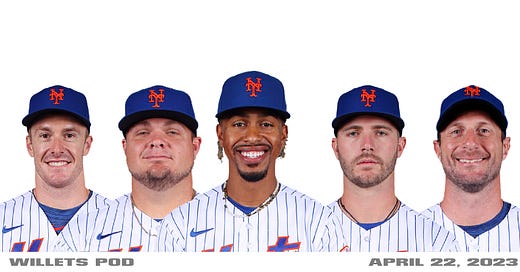The other day, I wrote on the We Can Pod It Out show notes, “an extensive accompanying newsletter that I hope to write” could be part of this episode. Sorry to tell you that it is not, but glad to tell you that my digital journalism urge to do power rankings of baseball managers’ celebratory throwability was beaten back. Instead, please enjoy this video of Tsuyoshi Shinjo, whose exploits in Japan we discussed on this show, throwing out Robin Ventura by so much at third base, Ty Wigginton had to look for him.
That play was in 2003, when Shinjo hit .193/.238/.246 with no stolen bases and only four extra-base hits in 124 plate appearances… and still was above replacement level (0.2 bWAR) because of his defense.
That got me curious, and rather than expand on things said on a podcast, why not stay true to Willets Pen style, and use this as an opportunity to learn something weird.
Thanks to Stathead, here are the most plate appearances in a season for players with positive WAR and negative oWAR (the offensive component)…
Warren Cromartie, 1979 Montreal Expos: 710 (1.8, -0.3)
Rico Brogna, 1999 Phillies: 679 (0.2, -0.2)
Bill Collins, 1910 Boston Doves: 660 (0.2, -1.0)
Rick Bosetti, 1979 Blue Jays: 657 (0.5, -0.3)
Manny Trillo, 1976 Cubs: 649 (0.2, -0.2)
…and for Britt’s sake…
Pedro Feliz, 2006 Giants: 644 (1.8, -0.2)
The top one of these seasons for the 21st century, when we have more reliable WAR components, is something for sure.
For the Mets, the guy you’d probably expect is on the team list (on which Shinjo’s 2003 ranks 52nd in team history), but not at the top…
Hubie Brooks, 1983: 624 (0.2, -0.7)
Rey Ordoñez, 1999: 588 (2.8, -0.4)
Jeromy Burnitz, 2002: 550 (0.1, -0.1)
Ordoñez, 1996: 530 (0.9, -0.1)
Jeff Francoeur, 2010: 447 (1.1, -0.6)
For a full career, Ordoñez ranks 11th in baseball history at 3,407 plate appearances with a 1.2 career WAR and -3.7 career oWAR. The top 10?
Tim Foli (1970-85): 6,573 (5.6, -0.3)
Neifi Pérez (1996-2007): 5,510 (2.6, -3.4)
César Izturis (2001-13): 4,679 (6.1, -0.9)
John Corkhill (1883-92): 4,614 (5.1, -2.1)
Pedro Feliz (2000-10): 4,544 (5.6, -0.7)
Malachi Kittridge (1890-1906): 4,464 (1.6, -0.2)
Jimmy McAleer (1889-1907): 4,423 (1.5, -3.0)
Mike Lum (1967-81): 3,999 (5.1, -0.1)
Hugh Nicol (1881-90): 3,825 (4.1, -0.9)
Mark Lemke (1988-98): 3,664 (6.1, -1.7)
Kittridge is interesting because his name jumps out, and because he’s 45th all-time in career passed balls with 202. But for context, that’s one fewer than Hall of Famer Jim O’Rourke, 108 fewer than Hall of Famer Connie Mack, 158 fewer than Hall of Famer Buck Ewing, 218 fewer than Hall of Famer King Kelly, 289 fewer than Hall of Famer Wilbert Robinson, 303 fewer than Hall of Famer Deacon White… and 561 behind all-time passed ball king Pop Snyder.
Want to talk about the unbreakable records in sports? Pop Snyder had SEVEN HUNDRED AND SIXTY-THREE PASSED BALLS. Drew Smith threw 780 pitches for the Mets last season. Casey Stengel sure was right about the Mets picking Hobie Landrith at the start of their expansion draft, that without a catcher, you have a lot of passed balls… but in the era he grew up in, it didn’t seem to matter.
The active leader in passed balls, Yasmani Grandal, has 92. There were seven seasons in the 19th century where that wouldn’t have led the league, from Rudy Kemmier’s record 114 in 1883 to Doc Bushong’s 95 in 1881.
Only one post-integration player is even in the top 50 all time for passed balls, and it’s eight-time All-Star Lance Parrish, who had 192 of ‘em from 1977-95 with the Tigers, Phillies, Angels, Mariners, Cleveland, Pirates, and Blue Jays.
In 600 major league games this year, there’s been a total of 31 passed balls. In 1884, there were 3,907 in 3,074 games. So, from 1.27 passed balls per game to 0.05 passed balls per game, all in just a matter of 139 easy years!













Share this post